I’ve been using SE Ranking since 2021 to track my blog’s keyword performance – not because it’s perfect, but because it does what I need at a price I can afford.
Let me be clear: I’m not an SEO agency. I’m a blogger who’s paid for SE Ranking with my own money for 4+ years, tracking thousands of keywords and running hundreds of site audits. This isn’t sponsored content.
This SE Ranking review is completely honest. I’ll share exactly what works brilliantly, what frustrates me occasionally, and who should (or shouldn’t) spend their money on SE Ranking in November 2025.
This article contains affiliate links. If you purchase SE Ranking through my links, I earn a commission at no extra cost to you. However, every opinion here is based on my 4+ years of real usage since 2021.
What will you learn in this review?
- How SE Ranking’s features perform in real-world daily use (not marketing claims)
- Honest pricing breakdown with hidden costs revealed
- When SE Ranking beats Semrush and Ahrefs (and when it doesn’t)
- Whether SE Ranking is worth $65-$259/month for bloggers, freelancers, or agencies
- Real pros and cons from someone who checks rankings almost every morning
If you’re tired of vague “this tool is amazing” reviews, you’re in the right place. Let’s dive into what SE Ranking actually delivers after 4+ years of daily use.

Quick Verdict
My Honest Take (After 4+ Years)
However, if you need:
Bottom Line: The 14-day free trial is completely risk-free. Test the rank tracker, run a site audit, and see if it fits your workflow. If you’re budget-conscious and SEO-focused (not PPC), SE Ranking is an excellent choice.
No Credit Card Required • Cancel anytime • Full feature access

What’s New in SE Ranking (2025)?
SE Ranking has evolved significantly since I started using it in 2021. The platform rolled out major updates in 2024-2025 that genuinely improved performance. Here’s what changed—and why it matters if you’re considering this tool in November 2025.
Major Updates (2024-2025)
- 10x growth in the referring domains database for Backlink Checker
- 30% more keywords added to the Competitive Research database
- 29% more accurate organic traffic estimations using AI-powered algorithms
New Tools Launched:
- Insights Tool – Automatic alerts for high-potential keywords, competitor movements, keyword cannibalization, and traffic spikes/drops
- Share of Voice metric – Track your website’s organic traffic share vs competitors
- AI-powered Content Editor – Smarter keyword recommendations and semantic analysis
- Website Audit 2.0 – Enhanced technical SEO checks and Core Web Vitals analysis
The Bottom Line: The platform I use today is fundamentally more powerful than what I paid for in 2021. These updates justify the small price increase—you’re getting significantly more value per dollar.
SE Ranking Review: What Is It?
SE Ranking is an all-in-one SEO platform designed to help website owners, bloggers, and agencies improve their search engine visibility by tracking keyword rankings, auditing sites, analyzing competitors, and much more —all from a single dashboard.
Founded in 2013 (originally launched in 2012 by Valery Kurilov and Alex Dymovich), SE Ranking has grown into a comprehensive SEO toolkit trusted by over 1.5 million users across 190+ countries.
Think of it as your complete SEO command center. Instead of juggling multiple SEO tools, SE Ranking combines keyword research, rank tracking, site audits, backlink analysis, competitor research, and content optimization into one affordable platform.
My Experience: Why I Chose SE Ranking in 2021
When I started using SE Ranking in 2021, I was looking for a simple tool to track my blog’s keyword rankings without spending $100+/month on premium tools like Semrush or Ahrefs. At that time, I was managing a growing blog, tracking around 200 keywords, and needed reliable data without the enterprise-level price tag.
SE Ranking was the perfect fit for my needs. Earlier, its Optimum plan cost $31/month (now called the Essential plan at $65/month). It gave me almost all the important features I used in other expensive tools—but at less than half the price. I could track daily rankings, run monthly site audits, research keywords before writing posts, and analyze what my competitors were doing—all within my budget.
Four years later, I’m still using it because it continues to deliver what I need without unnecessary complexity or costs.
Who Should Use SE Ranking?
Here’s who benefits most from this tool:
Perfect for:
- Solo Bloggers tracking 100-500 keywords across 1-5 websites
Why it works: Affordable pricing, daily rank tracking, unlimited reports—everything a blogger needs without extra fluff.
- Freelance SEO Consultants managing 3-10 client websites
Why it works: White-label reports (Pro plan), multiple projects, and competitive pricing let you stay profitable while delivering professional results.
- Small Marketing Agencies needing client-facing reports
Why it works: White-label reporting, team collaboration features (Pro/Business plans), and you can manage 30-50+ projects depending on your plan.
- Budget-Conscious Users who need core SEO features
Why it works: At $65-$119/month, you get 80% of what Semrush offers at 40% of the cost. Perfect if budget is a concern, but you still need professional tools.
Who Shouldn’t Use SE Ranking?
SE Ranking isn’t for everyone. Here’s who should avoid SE Ranking:
Not ideal for:
- Large Enterprises (1000+ employees)
Why: Limited API integrations, slower crawl speeds for massive sites (10,000+ pages), and a lack of dedicated account managers that enterprise tools provide.
- PPC-Focused Marketers running heavy Google Ads campaigns
Why: SE Ranking’s paid search tools are basic. If you need deep PPC analysis, Semrush or SpyFu are better choices.
- Users Needing the Largest Backlink Database
Why: SE Ranking’s backlink index is about 20-30% smaller than Ahrefs. If backlink research is your primary need, Ahrefs wins.
- Those Wanting a Free Plan
Why: SE Ranking only offers a 14-day free trial (no credit card required). There’s no permanent free plan like Semrush offers.
How SE Ranking Positions Itself?
SE Ranking sits in the middle ground between basic tools (like Ubersuggest) and premium enterprise tools (like Semrush/Ahrefs). It’s designed for professionals who need reliable data without paying enterprise prices.
Simple comparison:
- Ubersuggest: Cheaper but less accurate, limited features
- SE Ranking: Affordable, accurate, comprehensive core features ✅
- Semrush/Ahrefs: More comprehensive but 2x-3x more expensive
If you’re a blogger, freelancer, or small agency, SE Ranking likely offers the best value for your dollar. If you’re running an SEO company with an unlimited budget, you’ll probably need Semrush Enterprise or Ahrefs Agency.
After 4+ years of use, that’s exactly what I’ve found it to be. It tracks my rankings accurately, catches technical issues I’d miss manually, and helps me find keyword opportunities—all without costing more than my blog’s monthly revenue.
Now let me show you exactly which features I use most and how they perform in real-world scenarios.
SE Ranking Features Breakdown
Now that you understand what SE Ranking is and who it’s for, let me walk you through the features I actually use. I’m not going to list every feature the tool offers. Instead, I’ll focus on the ones that matter most for bloggers and small agencies, based on my 4+ years of hands-on experience.
Rank Tracker (My Most-Used Feature)
This is the feature I check almost every morning. SE Ranking’s Rank Tracker shows me exactly where my blog posts stand for target keywords across different search engines and locations. It’s the core reason I subscribed in 2021, and it remains my most-used tool.
For a beginner, rank tracking is like checking your position in a race. When you publish a post targeting “your keyword,” you want to know: Where does my page appear in Google? Position 1? Position 50? SE Ranking checks this automatically and shows your rankings without manual searching.
What I like the MOST?
1. Location-Specific Tracking
I track rankings for both India and the United States simultaneously. This matters because Google shows different results by location. My “SE Ranking pricing” post ranks position 28 in India but position 17 in the US—without location tracking, I’d never know this difference.
2. SERP Feature Tracking
SE Ranking tracks 16+ SERP features, including featured snippets, People Also Ask boxes, image packs, and video carousels. I discovered one of my posts appeared in a People Also Ask box even though it ranked position 15 organically—this brought extra traffic I wouldn’t have known about.

3. Competitor Comparison
Track up to 5-20 competitors (plan-dependent) for the same keywords. When a competitor jumps from position 18 to position 8, I visit their page to see what changed. This helps me learn from their strategies without manually checking each one.
4. Historical Data Graphs
SE Ranking stores ranking history from day one. Visual graphs show upward trends, sudden drops from algorithm updates, or seasonal patterns. I’ve tracked some keywords for 18+ months, and these graphs prove which content strategies work over time.
5. Multiple Search Engines
Track Google, Bing, YouTube, Yahoo, and others. I primarily use Google India/US, but occasionally check YouTube rankings for tutorial videos.
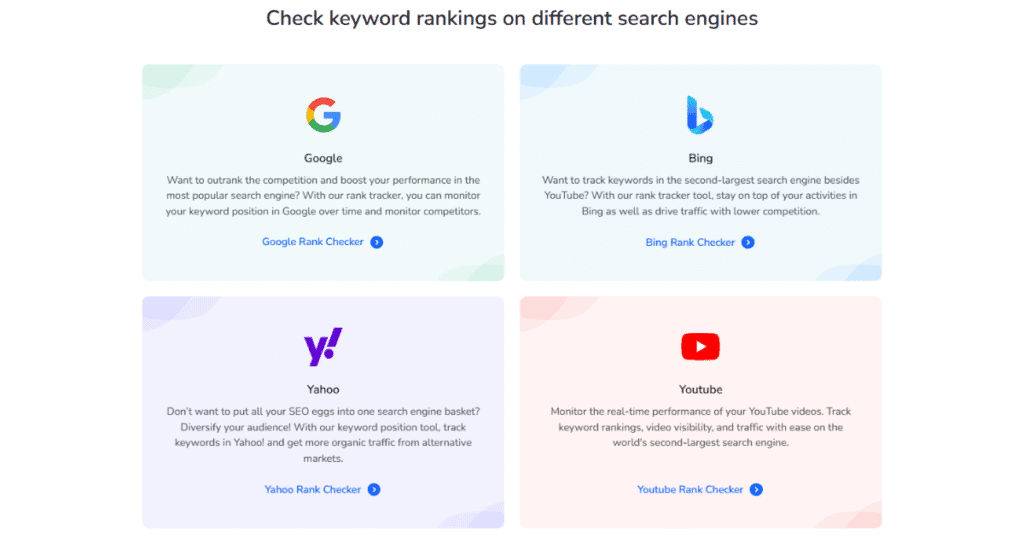
What Could Be Better?
1. Updates Aren’t Real-Time
Rankings update daily, but there’s a 6-12 hour lag from actual Google results. When I manually check, SE Ranking might show position 53 while Google shows position 52. The 1-3 position difference doesn’t affect trend monitoring, but it’s not real-time accurate.
2. Mobile vs Desktop Credits
Tracking both mobile and desktop for one keyword uses 2 credits. On the Essential plan (500 credits), you might run out quickly. My strategy: Track desktop only for most keywords, add mobile tracking only for high-priority ones. Google Search Console gives free mobile+desktop data as backup.
Quick Tips for Beginners:
- Start small: Track 10-20 most important keywords initially, not 500. Add more as you learn the tool.
- Set realistic expectations: Rankings take 3-6 months to improve significantly. Don’t get obsessed with daily rank changes; monthly trends are signals.
- Use ranking alerts: SE Ranking emails you when positions drop below your threshold or break into the top 10. Set these up and stop obsessive daily checking.
- Cross-reference with Google Search Console: SE Ranking shows positions; GSC shows actual clicks and impressions. Together, they give the complete picture.
Want to dive deeper? Read my detailed SE Ranking Rank Tracker Review.
👉 My Recommendation: Rankings take time. Daily fluctuations of 2-5 positions are normal—I focus on monthly trends, not daily panic. SE Ranking’s graphs make this easy to visualize.
My rating: ⭐⭐⭐⭐½ (4.5/5) — Still my most-used feature after 4+ years.
Website Audit Tool
I run website audits monthly to catch technical issues before they hurt my rankings. I think that everybody should treat a website audit like a health checkup for your blog – it scans every page, identifies problems (broken links, slow loading, missing meta descriptions), and tells you exactly what needs fixing.
SE Ranking’s Website Audit tool checks 115+ technical factors across your entire site, which includes crawlability, indexing, page speed, mobile usability, internal linking, and HTTPS implementation. After scanning, it gives you an overall health score (0-100%) and groups issues by priority: critical errors, warnings, and notices.

What do I Check Regularly?
1. Broken Links (404 Errors)
It identifies every broken internal and external link on your site. Broken links hurt user experience and can negatively impact SEO. I fix these whenever they’re flagged – these usually arise due to deleted pages or changed URLs.
2. Duplicate Content Issues
Sometimes, unknowingly, meta descriptions and H1 headings overlap across multiple pages, where it comes into play and detects them. Ultimately, I rewrite them to make each page unique.
3. Missing Alt Tags
It flags pages where images are inserted without Alt Text. Google can’t read images; instead, its algorithms go through what the Image Alt text presents to index it. So, it’s very necessary to fix these errors, and I write custom Alt texts for any flagged images.
4. Page Load Speed Issues
This tool identifies slow-loading pages (above 3-4 seconds). Slow pages hurt both user experience and rankings. When flagged, I compress images, minify CS/JavaScript, or switch to faster hosting.
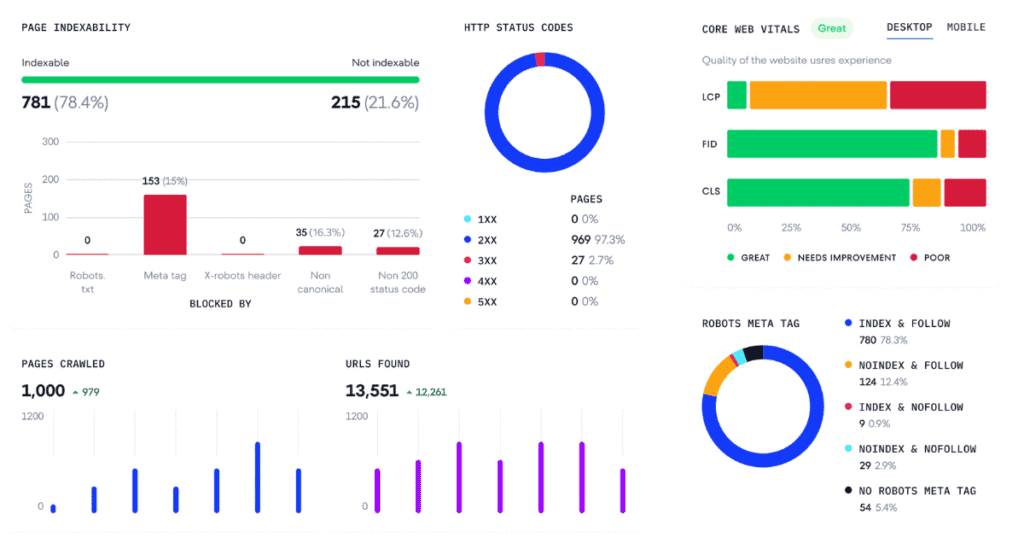
5. Other Technical Checks
In addition to these major checks, it detects canonical tags, robots.txt settings, sitemap errors, HTTPS implementation, internal linking structure, redirect chains, and Core Web Vitals.
How Website Audit Helped Me?
I typically run full audits after major site changes – like switching themes, adding new plugins, or restructuring categories. Audits often catch issues I’d miss manually.
Common Findings On My Blog:
- Broken internal links from deleted posts: Sometime back, I wrote 2-3 posts on a similar type of topic to enhance topical authority. But, later on, I realized that it was confusing Google and my readers because the search intent of those posts was overlapping. So, I merged them into one and deleted other pages, but I forgot to check for internal links that were pointing from deleted posts. Luckily, the website audit detected it, and I fixed it the same day.
- Slow-loading pages/images: It always hurts anyone who visits a webpage, and it keeps on loading, or the photos won’t show for 3-4 seconds. The same thing happened to me, and I came to know about it when I ran a website audit. It gave me a list of pages/images that were loading slowly. I fixed them immediately instead of wondering why those pages stopped ranking.
- Missing alt text on images: It takes me a lot of time to design attractive featured images for my blog posts. I wanted to know why these were not ranking on Google. If I had not run a website audit, I wouldn’t have found out the reason manually, as it is pretty time-consuming to analyze each image. But the audit immediately flagged the images with no alt text, and I fixed them without a second delay.
Limitations of Website Audit
An honest assessment is not complete until you discuss its improvement areas or limitations.
1. Learning Curve for Beginners
The audit dashboard shows 115+ checks grouped into 16 categories. First-time users might feel overwhelmed figuring out which issues to prioritize. I recommend starting with critical errors only, then gradually tackling warnings.
2. No Staging Site Audit
Unlike Semrush, SE Ranking can’t audit staging/development sites behind authentication. You can only audit live, publicly accessible websites. This means testing fixes requires auditing your live site.
3. JavaScript Rendering Costs Extra
If your site uses heavy JavaScript, you need JavaScript rendering enabled to audit dynamic content properly. This feature is not available in the Essential plan, and you have to pay more to use it in the Pro/Business plans.
Quick Tips for Effective Audits:
- The monthly schedule is ideal: Weekly audits generate too many reports; quarterly audits miss timely issues to fix. My recommendation is to set the website audit to monthly.
- Fix critical errors first: You need not try fixing everything at once. Your priority should be on broken links, indexing problems, and crawl errors first.
- Compare results over time: SE Ranking’s comparison feature shows whether your fixes are working or not. You should track your health score month-to-month.
My rating: ⭐⭐⭐⭐ (4/5) — Solid audit tool for beginners with room for more detailed fix recommendations.
Backlink Checker
Backlinks are links from other websites pointing to yours. Think of them as votes of confidence—more quality backlinks generally mean higher rankings. SE Ranking’s Backlink Checker helps you monitor who’s linking to you, assess link quality, and spot potentially harmful spam links.
Honestly, SE Ranking’s backlink database isn’t as comprehensive as Ahrefs or Majestic. But after using it for 4+ years, I’ve found it’s good enough for monitoring my blog’s link profile without paying premium prices for features I rarely use.
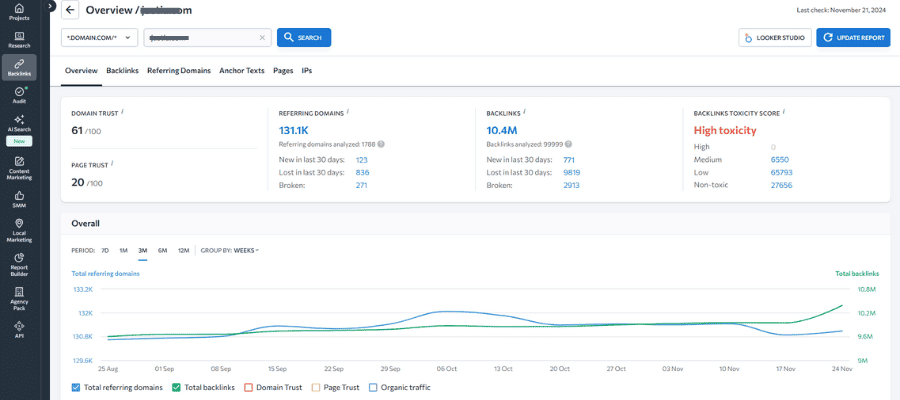
What Do I Actually Track?
1. New Backlinks Acquired Each Month
I check this at the start of every month to see which sites are linked to my blog naturally (or from outreach campaigns). SE Ranking shows new backlinks with dates, so I can correlate link acquisition with traffic spikes or ranking improvements.
2. Referring Domains Count
This is the metric I watch most—how many unique websites link to mine. SE Ranking tracks total referring domains and shows the monthly growth trends. More importantly, it separates dofollow vs nofollow links, which matters for SEO value.
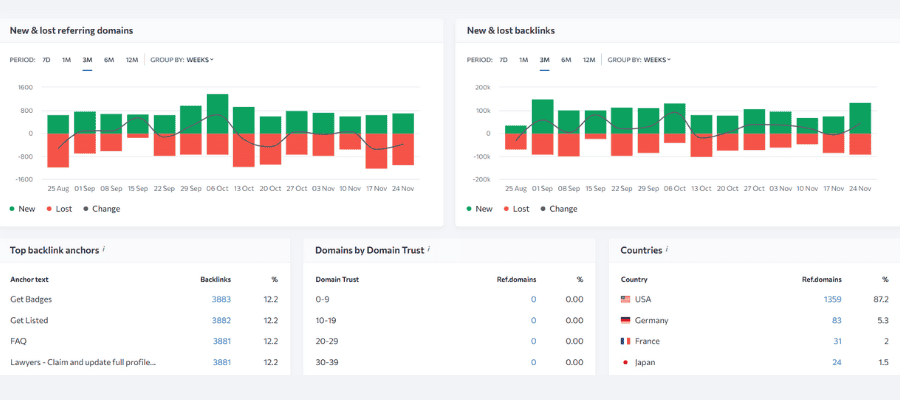
3. Toxic Backlinks
SE Ranking assigns spam scores to backlinks and flags potentially harmful ones. I review these quarterly and disavow obvious spam (adult sites, foreign gambling sites, scraper blogs). However, I don’t obsess over every flagged link—Google is smart enough to ignore most spam automatically.
4. Anchor Text Distribution
The tool shows which anchor texts people use when linking to you. Healthy anchor text should be varied: branded terms (“DabasBlog”), naked URLs (“dabasblog.com”), and topical keywords (“blogging tips”). If 80% of your anchors are exact-match keywords, that’s a red flag for unnatural link building.
5. Domain Trust & Page Trust Metrics
SE Ranking provides its own authority scores (0-100 scale) similar to Moz’s Domain Authority. While not official Google metrics, they’re useful for quickly assessing if a backlink is worth pursuing or disavowing.
The Database Reality: I occasionally cross-check SE Ranking’s backlink data with Ahrefs to identify any discrepancies. The gap exists, but it’s not as dramatic as you might think.
Real-World Monitoring
I treat backlink monitoring differently from rank tracking. I don’t check backlinks daily—that’s a waste of time. Instead, I review the Backlink Checker monthly, usually on the first Monday, when planning content for the month.
What do I look for:
- Growth: Are referring domains increasing or stagnant?
- New quality links: Did any authority sites link to me naturally?
- Lost links: Did any important backlinks disappear? (This happens when sites go offline or remove content)
- Spam patterns: Are there sudden spikes in low-quality links? (Could signal negative SEO)
When it helped most: I noticed a sudden inflow of 40+ backlinks from random blogs with foreign language anchors. SE Ranking’s spam score flagged them immediately, and I disavowed them through Google Search Console before they could potentially harm my rankings.
Where SE Ranking Falls Short?
1. Smaller Index Than Ahrefs
Let’s not sugarcoat it: SE Ranking’s backlink database is noticeably smaller than Ahrefs. If you’re in a hyper-competitive niche where every backlink matters, or you’re doing professional link-building for clients, Ahrefs provides more comprehensive data.
|
Tool |
Backlinks Indexed |
Domains |
Pages in Index |
|---|---|---|---|
|
SE Ranking |
2.9T |
357M |
6B |
|
Ahrefs |
28T |
500M |
493B |
The above-mentioned data is fact-checked and updated on 5 Nov 2025
2. Slower Backlink Detection
New backlinks sometimes take 2-4 weeks to appear in SE Ranking’s index. Ahrefs typically finds them within days. For most bloggers, this delay doesn’t matter—backlinks accumulate slowly anyway. But if you’re running active outreach campaigns and want immediate confirmation, it’s frustrating.
3. Limited Historical Data
SE Ranking stores 12 months of backlink history. Ahrefs goes back several years. If you need to analyze long-term link-building trends or recovery from a Google penalty years ago, SE Ranking won’t help.
Quick Tips for Backlink Monitoring
- Monthly checks are sufficient: Unlike rank tracking (daily), backlinks grow slowly. Monthly checks prevent you from wasting time.
- Focus on referring domains, not total backlinks: 10 unique domains linking to you matter more than 100 links from the same domain.
- Don’t panic over spam scores: SE Ranking flags potential spam, but Google ignores most of it automatically. Only disavow obvious spam (adult sites, gambling, foreign language spam).
- Use Backlink Gap for outreach: Compare your profile with competitors, find sites linking to them but not you, then pitch those sites.
- Cross-check important metrics with GSC: Google Search Console shows which sites Google actually discovered linking to you. Use it alongside SE Ranking for complete visibility.
My rating: ⭐⭐⭐½ (3.5/5) — Good enough for most users, but not industry-leading.
Competitor Research
Competitor research means analyzing other websites in your niche to understand why they rank higher than you. Which keywords are they targeting? What content format works for them? How strong is their backlink profile? SE Ranking answers these questions without requiring you to manually research each competitor.
I analyze top-ranking competitors regularly to understand what’s working in my niche. This tool helps me to see which keywords they rank for, how much traffic they’re getting, and where their backlinks come from.
Features I Actually Use
1. Top Competitor Keyword Lists
SE Ranking shows me every keyword a competitor ranks for in organic search—sorted by position, search volume, and keyword difficulty. This is a goldmine of data for content planning.
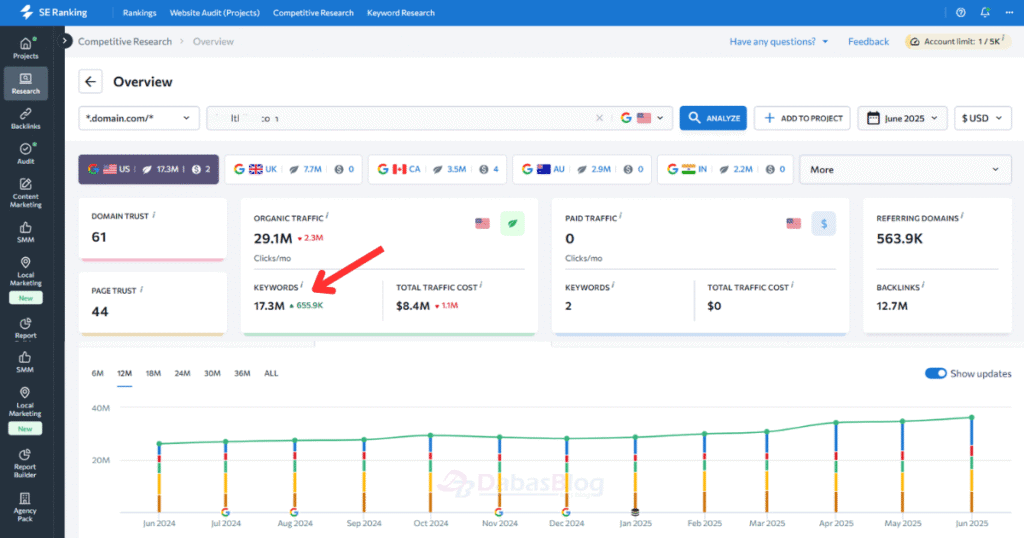
How I use it: I enter a competitor’s domain, filter for keywords ranking in positions 1-10, and scan the list for topics I haven’t covered yet. If a competitor ranks for “best blogging tools for beginners” and I don’t have that post, I add it to my content calendar.
Why it’s useful: You’re not guessing what content to create—you’re seeing what already works in your niche.
2. Estimated Organic Traffic
SE Ranking estimates the monthly traffic competitors receive from organic search. This helps me identify which competitors are genuine threats versus those with inflated domain authority but low actual traffic.
Real insight: I discovered a competitor with 10,000 backlinks but only 2,000 monthly visitors. Their content quality was poor despite the links. Meanwhile, another competitor with 500 backlinks gets 15,000 monthly visitors because their content answers user intent perfectly. SE Ranking’s traffic estimates (29% more accurate after 2024 updates) revealed this pattern.
3. Top Performing Pages
SE Ranking shows which specific pages drive the most traffic for competitors. This reveals their content strategy—are they winning with long-form guides? Product reviews? Comparison posts?
Insight: I noticed my top competitor gets 40% of their traffic from 5-6 pillar posts, not hundreds of thin posts. This shifted my strategy from quantity to quality—I now focus on creating fewer but more comprehensive posts.
What Works Well
1. 30% Larger Keyword Database (2024 Update)
SE Ranking expanded its competitor keyword database by 30% in 2024, especially for Germany, Spain, Brazil, France, Italy, and Australia. More keywords mean better competitor analysis.
2. Domain and Page Trust Metrics
SE Ranking shows authority scores for competitor domains and individual pages. This helps assess whether a competitor’s high ranking comes from strong authority or good content. Sometimes lower-authority sites with better content outrank high-authority sites—this metric reveals that.
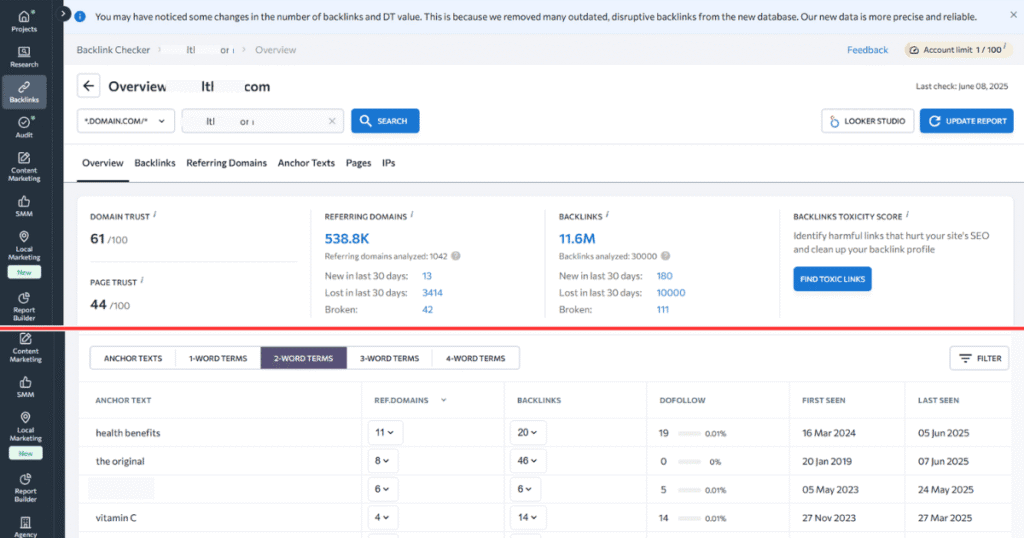
3. Backlink Comparison
Compare your backlink profile with competitors using the Backlink Gap Analyzer. It shows sites linking to competitors but not to you—potential outreach targets.
Where SE Ranking Falls Short?
1. Traffic Estimates Aren’t Always Precise
While 29% more accurate after 2024 updates, SE Ranking’s traffic estimates are still modeled predictions, not actual data. Sometimes a competitor’s real traffic (checked via SimilarWeb) differs by 30-40% from SE Ranking’s estimate.
Use them for: Relative comparisons (“Competitor A gets 2x traffic vs Competitor B”) rather than absolute numbers.
2. Limited Real-Time Competitor Alerts
SE Ranking doesn’t automatically alert you when competitors rank for new keywords or publish new content. You have to manually check periodically. Tools like SpyFu offer real-time competitor tracking alerts.
3. Basic Visualizations
Competitor data is mostly presented in tables and lists. Unlike Semrush’s colorful graphs and Venn diagrams, SE Ranking’s interface feels more utilitarian. For quick pattern recognition, visual dashboards help—SE Ranking could improve here.
Quick Tips for Effective Competitor Analysis
- Quarterly deep dives work: Monthly competitor checks create busywork without actionable insights. Quarterly analysis reveals real strategy shifts.
- Combine with manual research: SE Ranking shows the data; you still need to visit competitor sites to understand why their content works better.
- Use historical data wisely: Don’t just check current rankings—look at 6-12 month trends to spot consistent winners vs temporary spikes.
My rating: ⭐⭐⭐½ (3.5/5) — Good data, but workflow could be more efficient.
Read more: Complete SE Ranking Competitor Analysis Guide
Keyword Research Tool 🔑
Keyword research means finding what your audience actually types into Google. If you write about “blog tips” but people search for “blogging tips for beginners,” you’re missing traffic. SE Ranking’s keyword tool shows you what people search for, how often, and how hard it is to rank for those terms.
Before writing any blog post, I open SE Ranking’s keyword research tool. It’s become my starting point for every piece of content I publish. Why guess what people are searching for when you can see exact data—search volume, difficulty, competition, and dozens of related keyword ideas?
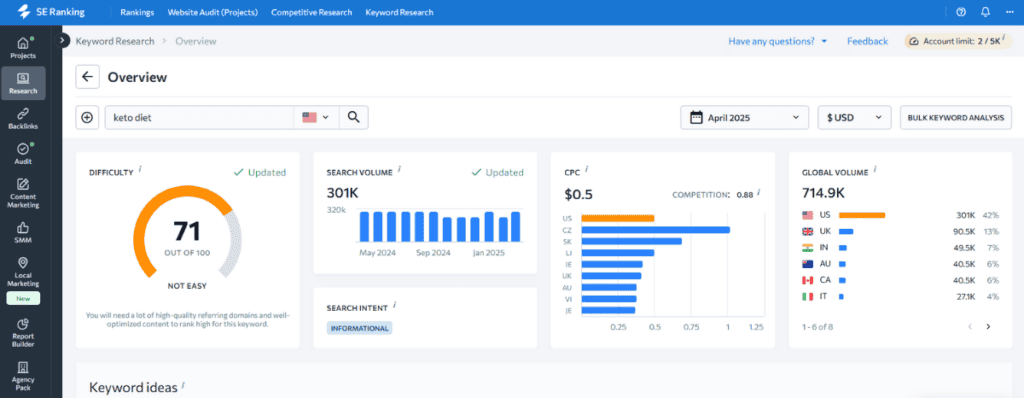
Metrics I Check (And Why They Matter)
1. Search Volume (Monthly)
This shows how many people search for a keyword each month. SE Ranking provides country-specific data—I can see volume for India separately from the US, critical since my audience spans both regions.
Beginner tip: Don’t only chase high-volume keywords (10,000+ searches). Keywords with 500-2,000 searches (long-tail keywords) often convert better because they’re more specific.
2. Keyword Difficulty (0-100 Scale)
SE Ranking calculates how hard it is to rank based on competitor strength:
- 0-30: Easy (newer blogs can rank within months)
- 31-60: Medium (requires decent content and backlinks)
- 61-100: Hard (dominated by authority sites)
My strategy: I target 70% easy-medium keywords (under 40 difficulty) and 30% challenging keywords (40-60) for long-term growth.
3. CPC Data (Commercial Intent)
CPC reveals how valuable a keyword is commercially. Keywords with $5+ CPC indicate buyer intent—people searching “best keyword research tool” are ready to purchase, not just browsing.
How I use it: For affiliate posts, I prioritize keywords with $3+ CPC. For informational guides, CPC matters less.
4. Related Keywords and Questions
SE Ranking shows similar keywords, question-based queries (“How to,” “What is”), and long-tail variations. The “Questions” section gives me exact subheadings for content—if people ask “how to choose blogging tools,” that becomes an H2 heading in my post.
My Simple Process
Step 1: Enter a seed keyword (like “keto diet”)
Step 2: Filter by search volume (500-5,000) and difficulty (under 20)
Step 3: Analyze related keywords that SE Ranking groups together
Step 4: Check CPC to understand commercial value
What Makes This Tool Stand Out?
1. Keyword Grouping
SE Ranking automatically groups similar keywords by topic clusters. Instead of 200 random keywords, you see them organized logically. This makes it easy to identify content ideas that cover multiple keywords in one post.
2. SERP Analysis for Each Keyword
Click any keyword to see the current top 10 ranking pages—their domain authority, backlinks, and word count. For “SE Ranking review,” I saw top posts averaged 3,500-4,500 words with 20+ backlinks. This informed my strategy.
3. Search Intent Classification
SE Ranking labels keywords by intent: informational, commercial, transactional, or navigational. Knowing intent prevents mistakes like writing a guide when users want to buy something.
4. Seasonal Trends Data
The tool shows if keywords spike during certain months. “Blogging tips” peaks in January (New Year’s resolutions). I schedule content to align with seasonal demand.
Where It Falls Apart?
1. Search Volume Accuracy Varies
SE Ranking’s estimates are solid but not perfect. Occasionally, a keyword shows 1,000 searches, but Google Search Console reveals only 400. The tool is directionally accurate—great for comparing keywords—but don’t treat numbers as the absolute truth.
2. Limited Ultra-Specific Long-Tail Depth
SE Ranking shows fewer 5-7 word phrase variations compared to Ahrefs’ massive database. For most bloggers, this doesn’t matter, but if you’re targeting hundreds of ultra-specific long-tails, you might need additional tools.
Note: Keyword research isn’t about stuffing keywords—it’s about understanding your audience’s language. When you write using exact phrases people search for, your content naturally ranks better.
Quick Tips For Beginners
- Start with low-competition keywords: Target difficulty under 30 for your first posts. Build authority before tackling harder keywords.
- Focus on search intent: Match your content type to what users want. Don’t write a buying guide for an informational query.
- Use related keywords naturally: Sprinkle 20-30 variations as subheadings and naturally throughout sentences.
- Check SERP results: Always analyze the top 10 ranking pages. If they’re all 4,000-word guides, your 1,000-word post won’t compete.
My rating: ⭐⭐⭐⭐½ (4.5/5) — One of SE Ranking’s strongest features.
Read more: SE Ranking Keyword Research Complete Guide

SE Ranking Exclusive Features ⚡
Beyond the core features, SE Ranking includes several bonus tools that make it feel like an all-in-one platform. Some of these I use occasionally; others are game-changers for agencies. Here’s what sets SE Ranking apart from basic rank trackers.
AI Search Toolkit 🤖 (2025’s Biggest Addition)
This is SE Ranking’s newest and most exciting feature suite—tracking your visibility in AI-powered search results like Google AI Overviews, ChatGPT, Perplexity, and Gemini.
Why it matters: Google’s AI Overviews now appear for 92% of some industries’ keywords. If you’re not tracking AI visibility, you’re missing a huge traffic opportunity.
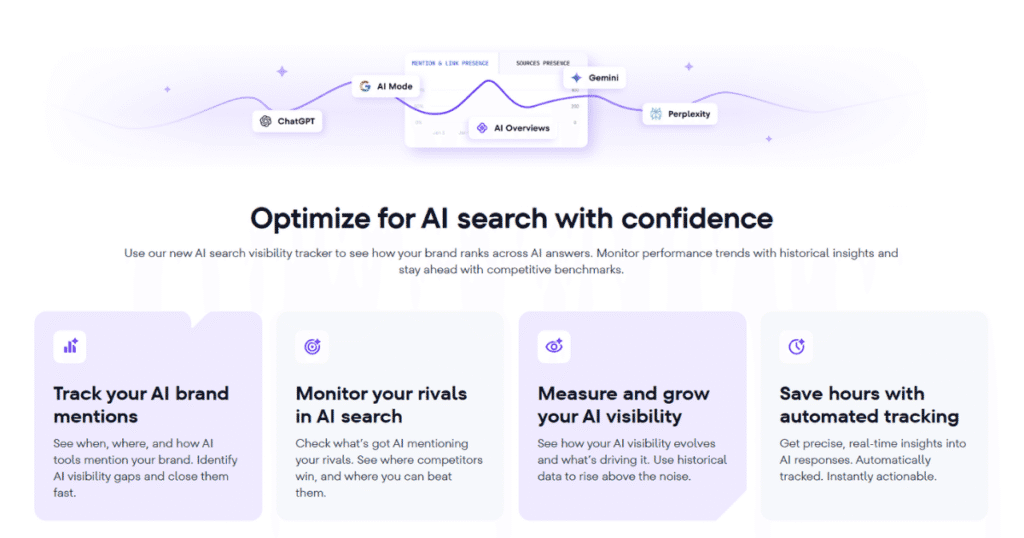
1. AI Overviews Tracker
Monitor whether your content appears in Google’s AI-generated answer snippets. SE Ranking shows which keywords trigger AI Overviews, whether you’re cited as a source, and your competitors’ AI visibility.
2. AI Mode Tracker
Track brand mentions and links in Google’s conversational AI Mode—both linked and unlinked mentions—helping you understand your authority in AI-generated responses.
3. Unified AI Visibility Tracker
See how often your brand appears across ChatGPT, Perplexity, Gemini, and other AI platforms. Measures your “share of voice” across topics with competitor benchmarks.
My take: This toolkit launched in 2025 and positions SE Ranking ahead of most competitors. For AI-era SEO planning, this feature alone justifies the subscription.
Content Marketing Module ✍️

1. Content Idea Generation
SE Ranking suggests topics based on competitor analysis, trending keywords, and content gaps. It’s like having a brainstorming assistant that never runs out of ideas.
2. SEO-Optimized Content Suggestions
The Content Editor (available as an add-on) analyzes top-ranking pages and recommends:
- Optimal word count targets
- Keywords to include naturally
- Semantic keywords for depth
- Readability improvements
- Content structure suggestions
3. On-Page Optimization Tips
Real-time scoring (0-100) shows how well your content matches search intent. Update your draft, and the score adjusts instantly.
👉 The Content Editor needs manual tweaking—I spend 10-15 minutes adjusting keyword parameters to get accurate scores. But once configured, it helps create SEO-optimized briefs.
SERP Tracker🔍
Do you want to know exactly why competitors rank higher? SERP Tracker dissects the top 10 results for any keyword.
What it shows:
- Average word count of ranking pages
- Domain and page authority scores
- Backlink profiles of top rankers
- SERP features present (snippets, videos, images)
- Content structure patterns
How I use it: Before writing a new post, I analyze the SERP to understand the competition. If all top 10 posts are 4,000+ words with 50+ backlinks, I know I need a comprehensive guide with strong promotion.
Read more: Complete SE Ranking SERP Analyzer Guide
White Label Reporting 📊 (Agency Essential)
Pro and Business plans include white-label reports—remove SE Ranking branding and add your agency’s logo, colors, and domain.
Features:
- Automated scheduled reports (daily, weekly, monthly)
- Custom branding with your logo and colors
- PDF, Excel, or CSV export formats
- Client portal access with guest logins
- Integration with Looker Studio for live dashboards
Why agencies love it: Send professional, branded reports to clients without manual work. Clients see your branding, not SE Ranking’s.
Additional Power Tools
1. Page Changes Monitor
Track specific pages for content updates, meta changes, or competitor edits. I monitor my top 5 posts—if competitors update theirs significantly, SE Ranking alerts me.
2. On-Page SEO Checker ✅
Analyzes individual pages for optimization opportunities:
- Title and meta description issues
- Heading structure (H1, H2, H3)
- Keyword density and placement
- Image alt text optimization
- Internal linking suggestions
- Content length compared to competitors
My practice: After publishing, I run the On-Page Checker to catch last-minute optimization misses before Google indexes the page.
3. Social Media Management 📱
Post scheduling and basic analytics for Facebook, Twitter, and Instagram. I’ll be honest—I don’t use this feature much (I prefer VistaSocial), but it’s there if you want an all-in-one solution.
4. Marketing Plan Builder
Generates a customized SEO roadmap based on your audit, competitor analysis, and keyword research. Prioritizes tasks by impact.
5. Lead Generator Tool
Finds businesses with poor SEO in your niche, including contact info and audit summaries for outreach. Gold for freelancers and agencies doing cold outreach.
👉 These bonus tools transform SE Ranking from a “rank tracker” into a complete SEO workspace. The AI Search Toolkit alone justifies subscribing in 2025—no other affordable tool tracks AI visibility this comprehensively.
These features show SE Ranking isn’t standing still—they’re actively innovating. For $65-$119/month, the value keeps increasing.
SE Ranking Review: My Honest Assessment
After walking you through SE Ranking’s core features and exclusive tools, it’s time for my unfiltered opinion. I’ve used this platform since 2021, paid for it with my own money, and tracked thousands of keywords across multiple blogs. Here’s what I genuinely think about SE Ranking in November 2025.
SE Ranking is the Toyota Camry of SEO tools—reliable, affordable, and gets the job done without fancy extras. It’s not the most dazzling option, but it’s the one that makes financial sense long-term.
I’m still a paying customer in November 2025. That should tell you something about its value.
The Question Everyone Asks: “Should I Switch from [Tool] to SE Ranking?”
From Ubersuggest: Yes. SE Ranking is more accurate and comprehensive for just $20-30 more per month.
From Semrush: Maybe. If you rarely use Semrush’s PPC tools or content marketing features, SE Ranking saves you $50-80/month.
From Ahrefs: Only if backlinks aren’t your primary focus. If you do heavy link building, stick with Ahrefs. If you mainly track rankings and do site audits, SE Ranking is cheaper.
From Moz: Yes. SE Ranking offers better value—similar features at comparable pricing, but with daily rank updates vs Moz’s slower updates.
Starting from scratch: SE Ranking is an excellent first tool. Use the 14-day trial to test it risk-free.
SE Ranking Pros and Cons ✅❌
After 4+ years of daily use, here’s my honest breakdown of what works and what doesn’t.
✅ What I Love
|
Pros |
Details |
|---|---|
|
Price |
50% cheaper – $65-119/mo vs $129-139 for Semrush/Ahrefs |
|
Free Trial |
14 days (no card) vs competitors’ 7 days |
|
Rank Tracking |
Daily updates on all plans |
|
Projects |
Unlimited on Pro/Business plans |
|
White Label |
Included on Pro+ (competitors charge extra) |
|
AI Toolkit |
Tracks ChatGPT, AI Overviews, Perplexity |
|
Historical Data |
4+ years back to 2020 |
|
Search Engines |
Google, Bing, YouTube, Yahoo |
❌ What Needs Work
|
Cons |
Details |
|---|---|
|
Backlinks |
Database 20-30% smaller than Ahrefs |
|
Large Sites |
Slower crawls for 1000+ pages |
|
Ranking Lag |
6-8 hour delay (not real-time) |
|
Limited PPC tools |
Not helpful for heavy Google Ads users |
|
API Access |
Business plan only ($259/mo) |
|
Free Plan |
No permanent free tier (only trial) |
|
Content Editor |
Needs 10-15 min tweaking per brief |
The Verdict
SE Ranking’s strengths outweigh weaknesses for bloggers, freelancers, and small agencies. You’re paying 60% less for 80% of the functionality. Limitations only matter if you’re an enterprise team or backlink research is your primary focus.
What Users Say About SE Ranking?
My opinion matters, but what do thousands of other SE Ranking users think? Here’s an honest look at user ratings, reviews, and complaints.
What Users Love
1. Value for Money ⭐⭐⭐⭐⭐
The #1 most mentioned praise across all platforms: “Best SEO tool for the price.”
“I switched from Semrush to SE Ranking and cut my monthly cost by 60% while keeping 90% of the features I actually use.”
– Sarah M., Freelance SEO Consultant (G2 Review, April 2025)
2. Daily Rank Tracking Reliability ⭐⭐⭐⭐⭐
Users consistently praise accurate daily ranking updates and historical data tracking.
“Rankings update every morning like clockwork. I’ve compared SE Ranking with manual Google checks—95% accuracy.”
– Rajesh K., Blogger (Capterra Review, June 2025)
3. White Label Reports ⭐⭐⭐⭐⭐
Agencies love the white-label reporting feature included in Pro plans.
“The white-label reports make me look professional to clients without expensive enterprise tools.”
– Digital Marketing Agency Owner (G2 Review, August 2025)
4. Responsive Customer Support ⭐⭐⭐⭐
Users frequently mention helpful support teams responding within 6-12 hours.
“I’ve contacted support 4 times in 2 years. Every time, they solved my issue within 24 hours.”
– Mark T., Small Agency (Trustpilot Review, September 2025)
5. AI Search Tracking ⭐⭐⭐⭐⭐
The new AI Overviews Tracker (2025) is getting exceptional reviews.
“Finally, a tool that tracks my visibility in ChatGPT and AI Overviews. No competitor offers this at this price.”
– Content Marketer (G2 Review, November 2025)
Common Complaints (What Users Criticize)
1. Learning Curve for Beginners ⭐⭐⭐
The most frequent complaint: The Interface feels cluttered initially.
“Took me 2 weeks to figure out where everything is. The collapsible menu system is confusing at first.”
– New User (Capterra Review, May 2025)
SE Ranking’s Response: They’ve added tutorial videos and a “Favorites” toolbar to simplify navigation.
2. Backlink Database Size ⭐⭐⭐
Users who switched from Ahrefs notice the smaller backlink index.
“SE Ranking found 180 backlinks to my site. Ahrefs found 240. The difference is mostly low-quality directory links I don’t care about anyway.”
– Blogger (G2 Review, July 2025)
SE Ranking’s Response: They increased the database 10x in 2024 and continue expanding.
3. Content Editor Manual Adjustments ⭐⭐⭐
Users mention the Content Editor needs parameter tweaking for accurate scores.
“The Content Editor is useful but requires 10 minutes of keyword adjustments every time. It should be smarter.”
– Content Creator (Trustpilot Review, June 2025)
SE Ranking’s Response: They launched Content Editor 2.0 with AI improvements in 2024, but it’s still being refined.
4. No Permanent Free Plan ⭐⭐⭐
Some users wish there were a freemium tier like Semrush or Moz.
“14-day trial is generous, but I wish there was a limited free plan to keep testing without commitment.”
– Startup Owner (G2 Review, August 2025)
SE Ranking’s Response: They maintain their 14-day no-credit-card trial as their free option.
SE Ranking delivers on its promise—affordable, reliable SEO tools for bloggers, freelancers, and small agencies. It’s not trying to be an enterprise tool, and users who understand that are extremely satisfied.
SE Ranking Pricing 💰 (November 2025)
SE Ranking uses a pay-per-keyword model with three main plans. Unlike Semrush or Ahrefs, which charge based on features alone, SE Ranking lets you customize how many keywords you track, giving you flexibility to control costs.
Current Pricing Plans (Annual Billing)
|
Plan |
Price (Annual) |
Keywords |
Projects |
Best For |
|---|---|---|---|---|
|
Essential |
$52/month |
500 |
10 |
Solo bloggers |
|
Pro |
$95/month |
2,000 |
30 |
Freelancers, small agencies |
|
Business |
$259/month |
5,000 |
50 |
Agencies, SEO teams |
Monthly billing is available at a 20% higher cost ($65, $119, $259, respectively).

What’s Included in All Plans?
Pro and Business add: White-label reports, AI Search Toolkit, team collaboration, priority support.
Hidden Costs You Need to Know
SE Ranking’s base pricing looks simple, but add-ons can increase your monthly bill:
Content Marketing Module (starts at $29/month)
Includes Content Editor, Content Idea Finder, and Text Optimizer (real-time SEO recommendations). Useful but not essential if you’re experienced with keyword research manually.
AI Toolkit (starts at $89/month)
Tracks your brand visibility in AI search results (ChatGPT, Google AI Overviews, Perplexity, Gemini). Essential for future-proofing SEO strategy but only available on Pro ($95/month) and Business ($259/month) plans.
Local Marketing Tool (starts at $23/month)
Manages Google Business Profile, local citations, review monitoring, and local rank tracking. Only relevant for local businesses (restaurants, dentists, plumbers) targeting specific cities.
Agency Pack (starts at $50/month)
Expands white-label capabilities with custom domain reporting, branded client portals, and team collaboration tools. Essential for agencies serving multiple clients but overkill for solo bloggers.
Extra Keywords (Pay-per-keyword beyond plan limits)
If you exceed your plan’s keyword limit (500 on Essential, 2,000 on Pro), you’ll pay additional fees for each extra keyword tracked.
My Pricing Recommendation
My experience with the SE Ranking tool says that you should start with the Essential plan and then upgrade to Pro only if you need.
Use the 14-day free trial first: Test rank tracking, keyword research, and site audits before committing. No credit card required.
Is SE Ranking Worth the Price?
Yes, if you’re a blogger, freelancer, or small agency needing core SEO tools without enterprise pricing.
My reality: I pay $95/month (Pro plan) for SE Ranking. Semrush would cost me $249/month for similar features. That’s $1,848/year savings.
📖 Read Complete Guide: SE Ranking Pricing Breakdown (November 2025) – Save Up to $621/Year
Who Should (and Shouldn’t) Buy SE Ranking 🎯
✅ You Should Buy SE Ranking If:
- You’re a blogger or small site owner tracking under 1,000 keywords
- Budget is a concern – You need core SEO tools under $100/month
- You need white-label reports for clients (freelancers/agencies)
- You focus on organic SEO, not PPC campaigns
- You want AI search visibility tracking – ChatGPT, AI Overviews, Perplexity
- Real example: If you’re like me – running 5-10 sites, tracking 500-1,000 keywords, checking rankings regularly – SE Ranking is perfect
❌ You Shouldn’t Buy SE Ranking If:
- You need advanced PPC tools for Google Ads campaigns (choose Semrush)
- You require the most comprehensive backlink database (choose Ahrefs)
- You need real-time ranking updates (SE Ranking lags 6-8 hours)
- You want a permanent free plan (only a 14-day trial available)
- You’re a large enterprise needing advanced API integrations
- Your site has 10,000+ pages needing daily crawls
Quick Decision Guide
- Choose SE Ranking: Budget-conscious + organic SEO focus + core features needed
- Choose Semrush: PPC tools + unlimited budget + enterprise features
- Choose Ahrefs: Backlink research primary focus + link building
My verdict: SE Ranking delivers 80% of premium functionality at 40% of the cost.
SE Ranking Alternatives
Wondering how SE Ranking stacks up against Semrush and Ahrefs? Here’s an honest side-by-side comparison.
SE Ranking vs Semrush
|
Feature |
SE Ranking |
Semrush |
|---|---|---|
|
Starting Price |
$65/month |
$139/month |
|
Keyword Database |
4.9 billion keywords |
26.6 billion keywords |
|
PPC Tools |
Basic (limited features) |
Comprehensive (ads, CPC, budgets) |
|
Content Tools |
Decent (Content Editor add-on) |
Excellent (built-in) |
|
Projects (Mid-Tier) |
30 projects |
15 projects |
|
Daily Rank Tracking |
2,000 keywords |
1,500 keywords |
|
White Label |
Included (Pro+) |
Included (Guru+) |
|
Best For |
Budget-conscious users |
Full-service SEO + PPC teams |
My Recommendation: Semrush is more powerful but costs 2x more ($139 vs $65/month). If you need advanced PPC tools, content marketing features, and the largest keyword database, Semrush justifies the cost. But if you primarily need rank tracking, site audits, and keyword research without breaking the bank, SE Ranking delivers 80% of the value at 40% of the price.
Winner: SE Ranking for value; Semrush for comprehensiveness.
SE Ranking vs Ahrefs
|
Feature |
SE Ranking |
Ahrefs |
|---|---|---|
|
Backlink Database |
2.9 trillion backlinks |
15+ trillion backlinks |
|
Site Explorer |
Good (basic competitor insights) |
Excellent (deep analysis) |
|
Keyword Research |
Good (4.9B keywords) |
Excellent (12B+ keywords) |
|
Rank Tracking |
Daily on all plans |
Daily on all plans |
|
Price |
$65/month |
$129/month |
|
Best For |
Bloggers, small agencies |
Link builders, backlink researchers |
My Recommendation: Ahrefs wins decisively on backlink analysis—its database is 5x larger and link detection is faster. If you’re doing heavy link building, competitor backlink research, or outreach campaigns, Ahrefs is worth the premium. However, for keyword tracking and site audits, SE Ranking delivers 80% of the functionality at 60% less cost ($65 vs $129/month).
Winner: Ahrefs for backlinks; SE Ranking for overall value.
SE Ranking vs Ahrefs: Which tool is best for SMBs?
Quick Decision Guide
|
Your Priority |
Choose This Tool |
|---|---|
|
Best overall value |
SE Ranking ($65/mo) ✅ |
|
Largest keyword database |
Semrush (27.5B keywords) |
|
Best backlink research |
Ahrefs (28T+ backlinks) |
|
Advanced PPC tools |
Semrush (comprehensive ads data) |
|
Budget under $100/month |
SE Ranking ✅ |
|
AI search visibility tracking |
SE Ranking (only tool with this) ✅ |
|
White-label reports on the budget |
SE Ranking (included in Pro $95/mo) ✅ |
The Honest Verdict
After using all three tools, here’s my take:
SE Ranking = Toyota Camry (reliable, affordable, gets the job done)
Semrush = Mercedes-Benz (premium features, premium price)
Ahrefs = Specialized sports car (best at one thing: backlinks)
If you’re a blogger or small agency on a budget, SE Ranking is the smartest choice. If you’re managing enterprise SEO with an unlimited budget, Semrush or Ahrefs justify the cost.
My Final Verdict ⭐
After 4+ years of daily use, here’s my honest conclusion: SE Ranking is a solid, budget-friendly SEO tool that does exactly what it promises—track rankings accurately, audit sites thoroughly, and research keywords effectively.
Who It’s Perfect For
If you’re a blogger, freelancer, or small agency owner needing core SEO features without spending $150+/month, SE Ranking is an excellent choice. I’ve tracked thousands of keywords, run hundreds of audits, and saved $1,848+ annually compared to Semrush.
The Reality Check
It’s not perfect. The Content Editor needs tweaking, backlink data isn’t as comprehensive as Ahrefs, and ranking updates can lag 12-24 hours. But for most users—including me—these aren’t dealbreakers. The tool reliably does what I need: track progress, catch technical issues, and reveal keyword opportunities.
My Recommendation
Start with the 14-day free trial (no credit card required). Track your keywords, run a site audit, test features you’ll actually use. If it fits your workflow, the Essential plan ($52/month annual) offers incredible value.
Why I’m Still Subscribed in November 2025
I’m still a paying SE Ranking customer in November 2025. That should tell you something about its long-term value.
Every tool has limitations, but SE Ranking’s strengths far outweigh its weaknesses for small-to-medium users.
If SE Ranking disappeared tomorrow, I’d reluctantly pay double for Semrush or scramble to piece together multiple cheaper tools. There’s no comparable replacement at this price point.
Ready to Try It?
👉 Get Your 14-Day Free Trial Here (No Credit Card)
What you’ll get: 500 keywords tracked daily, unlimited audits, full keyword research access, and competitor analysis tools.
Test it yourself and see if SE Ranking is the right fit for your SEO needs. If you’re like me, you’ll realize it’s exactly what you’ve been looking for—core SEO tools that work, at a price you can afford.
Current Discount: Save up to 20% with annual billing 💰
FAQs: SE Ranking Tool
Have you tested the SE Ranking tool? What is your overall experience with the tool? Please share it in the comments section.
👉 And please, don’t forget to share it.

About Author
Nitin Dabas is your SEO guide. Expert in keywords, on-page SEO, and link-building, he has boosted rankings for countless clients. Read his blog and join his success stories.


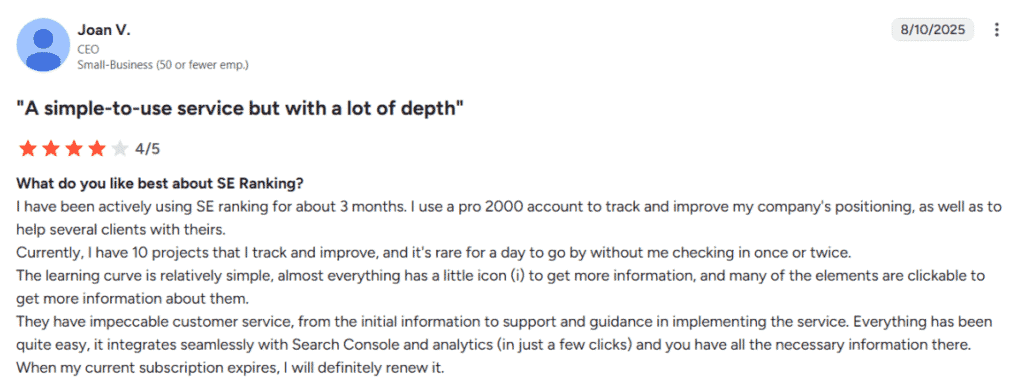

Hi Nitin,
I was wandering for the best SEO tool that does a perfect job and comes in my budget too. This SE Ranking review has cleared all my doubts to choose the tool that is a good alternative to SEMrush.
Thank you.
Thanks, Anil. I’m glad to see that you found it useful.
Cheers!
Hi Nitin,
Thanks so much for explaining this wonderful SEO tool. It sure is a good alternative to SEMrush.
-Donna
Thanks for the lovely feedback, Donna. It’s my pleasure.
Of course, it is a good alternative to SEMrush.
Sounds like a powerful tool Nitin. Sensational review, too. Tools do help make our lives easier if we pick good ones with super functionality. SE Ranking sounds like it has the SEO juice.
Ryan
Hi Ryan,
Of course, the SE Ranking tool has great functionalities. I use it for competitive analysis and keyword research.
It’s great that you liked the tool and review. Happy weekend 😊
You explained very well Nitin.
I come to know some new points via this article. Thank you for that.
Your way of reviewing this product is next level. Keep it this.
Thank you for this post.
Keep bring such awesome content on this blog.
Thank you for such lovely feedback, Venkat. It will motivate me to create such valuable articles. Have a great blogging journey ahead!